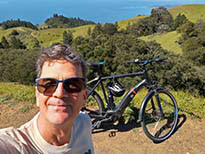My wife and I encountered some excellent cathedral beams (aka fog beams) during a hike last Sunday, when the only camera I had with me was a smartphone. The beams were so good that I drove back up today with my Nikon and high hopes, only to get skunked. Even at 7 a.m. the fog was too low on the mountain.
I decided to drive down the mountain to try to find the sweet spot where sun, trees, and fog conspire to create cathedral beams, but I was soon waylaid when I spotted a fox next to the road. I was lucky to find a safe pull-out not too far past him, and as I looked in my rear view mirror I saw a second fox that quickly ducked back into the woods. Thankfully I didn't leave my long lens at home again today.
I never saw the second fox again, but the other one, presumably the male, seemed eager to keep himself between me and his mate. That's how I interpreted the behavior, but I suppose this could be a female protecting the other fox which was her kit.
Right off the bat I heard a strange low rumbling sound, and it took me a minute to realize the sound was coming from the fox. I had never been growled at by a fox before. It was an interesting sound, and not one that you'd want to hear outside your tent in the middle of the night if you didn't know it was just a fox. I was surprised when the fox moved toward me, continuing to growl and occasionally to bark as well. This shot was the closest I came to catching it mid-bark.
The fox got bored with me before I got bored with him, and he moved down the steep hillside. The camera traps have been catching so many foxes, it was fantastic to finally have an in-person encounter.
After saying good-bye to the fox I drove down toward Stinson Beach to try to find some fog beams but didn't really find anything to compare with the beams we basked in on Sunday.
This was from Sunday's hike along the Bolinas Ridge Trail.
From Stinson, I drove out around Bolinas Lagoon and up Bolinas-Fairfax Road where I stopped to photograph these ferns in the diffuse light. It was just near this spot that I first photographed a gray fox on Mt. Tamalpais in May 2008.
I circled back along West Ridgecrest Road where I watched a coyote trot south near the grassland-forest transition zone before disappearing behind a roll in the hillside.
It was warm and sunny up there, so I removed my hat and put it on the roof of my car, then pulled my longjohn top off over my head. I tossed the longjohn top into the car and drove off with the hat still on the roof. I'd been thinking about getting a new hat anyway....
* * *




















































